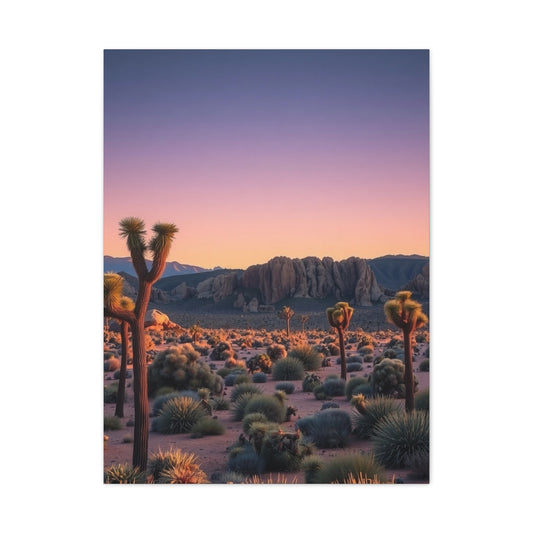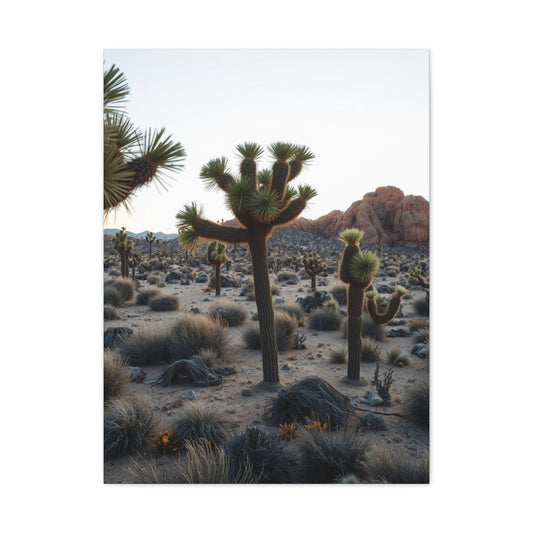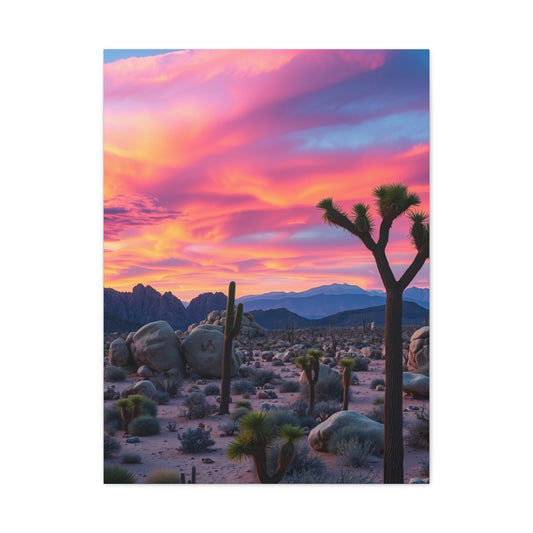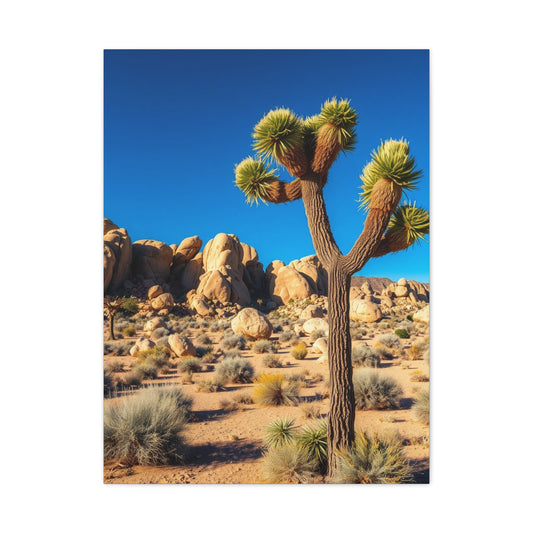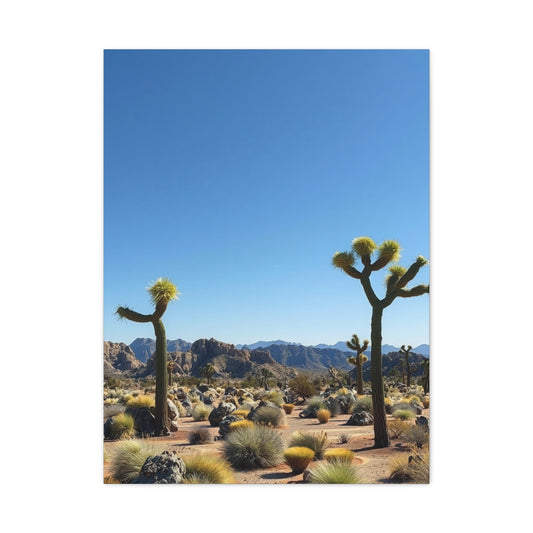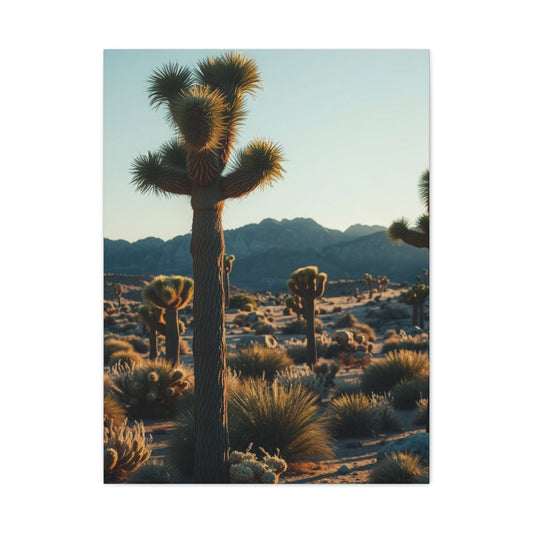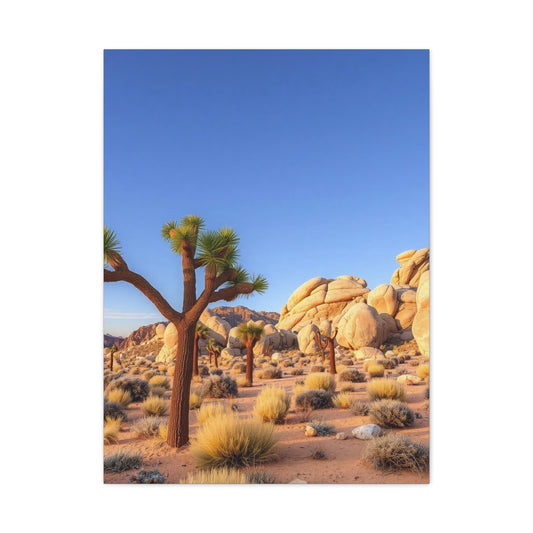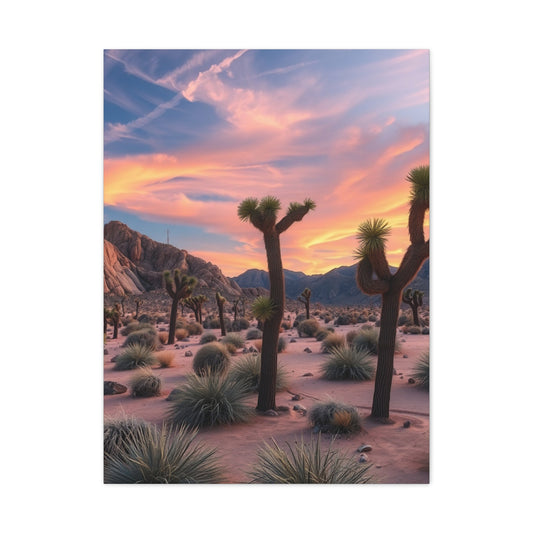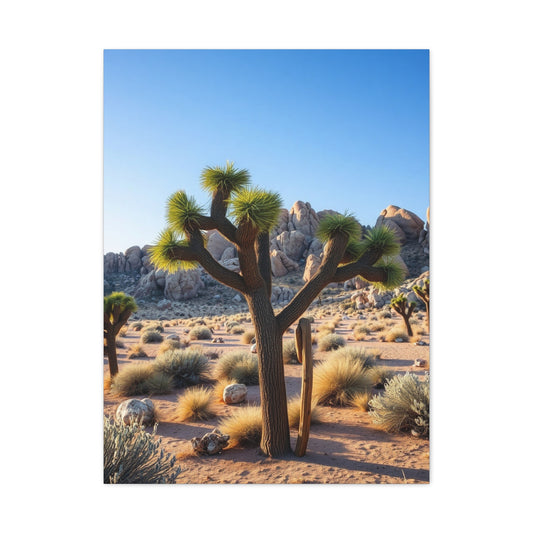Mystical Desert Landscapes: Transforming Your Space with Enchanting Joshua Tree Wall Art Collections
The allure of California's Mojave Desert has captivated artists, photographers, and nature enthusiasts for generations. Among its most distinctive features stands the otherworldly Joshua tree, a botanical marvel that has become synonymous with desert mystique and southwestern charm. These extraordinary specimens, with their twisted branches reaching skyward like ancient sculptures, have inspired countless artistic interpretations that now grace homes, offices, and galleries worldwide.
Joshua tree wall art represents far more than mere decoration; it embodies a connection to nature's raw beauty and the untamed spirit of America's desert wilderness. From ethereal sunrise photographs capturing golden light filtering through spiky branches to abstract interpretations emphasizing the tree's sculptural qualities, this genre of artwork offers endless possibilities for interior enhancement. The growing popularity of desert-themed décor has elevated Joshua tree imagery from regional curiosity to mainstream design element, appealing to those seeking to infuse their living spaces with natural wonder and southwestern sophistication.
Understanding the diverse manifestations of Joshua tree artwork requires appreciation for both the botanical subject and artistic medium. These distinctive succulents, scientifically known as Yucca brevifolia, create dramatic silhouettes against expansive desert skies, providing artists with compelling compositional elements that translate beautifully across various media. Whether rendered in photography, painting, digital art, or mixed media, Joshua trees offer visual impact that ranges from serene and contemplative to bold and striking.
Desert-Inspired Botanical Wall Art
The fascination with desert landscapes in contemporary interior design stems from our collective yearning for spaces that evoke tranquility, mindfulness, and connection to nature. Joshua tree wall art satisfies this desire while introducing unique visual elements that distinguish homes from conventional decorative approaches. These remarkable plants, existing primarily in the southwestern United States, represent resilience, adaptation, and timeless beauty—qualities that resonate deeply with modern sensibilities.
Desert botanical art encompasses various interpretations of arid landscape flora, with Joshua trees serving as perhaps the most recognizable and versatile subject matter. Their distinctive architecture—characterized by thick, branching trunks topped with clusters of sword-like leaves—creates natural sculptures that appear almost alien against their stark surroundings. This inherent drama translates exceptionally well to wall art, where the interplay between organic forms and negative space generates visual interest across diverse interior styles.
Contemporary artists approach Joshua tree subjects through multiple lenses, from hyper-realistic photography that captures every detail of bark texture and leaf formation to impressionistic paintings that emphasize mood and atmosphere over literal representation. Mixed media approaches combine photography with painting techniques, creating layered compositions that suggest both the physical reality of these desert dwellers and their symbolic significance as markers of endurance and natural beauty.
The color palette associated with Joshua tree art varies dramatically depending on artistic interpretation and environmental context. Dawn and dusk photography often emphasizes warm golden tones, coral pinks, and deep purples that contrast beautifully with the trees' muted green-gray foliage. Midday compositions might feature stark contrasts between brilliant blue skies and the sculptural forms of the trees themselves, creating bold graphic statements suitable for contemporary interiors. Monochromatic treatments, particularly in sepia or black-and-white, emphasize form and texture while maintaining timeless appeal.
Capturing Nature's Sculptural Masterpieces
The artistic interpretation of Joshua tree landscapes requires understanding both the unique characteristics of these remarkable plants and their environmental context within the broader Mojave Desert ecosystem. Professional photographers and artists who specialize in desert imagery often spend considerable time studying light patterns, seasonal changes, and atmospheric conditions that transform ordinary scenes into extraordinary artistic statements.
Joshua trees reach their full majesty over decades of slow growth, developing the twisted, architectural forms that make them such compelling artistic subjects. Mature specimens can stand twenty to forty feet tall, their massive trunks supporting multiple branching arms that create complex silhouettes against expansive desert skies. This natural architecture provides artists with endless compositional possibilities, from intimate close-ups focusing on textural details to sweeping vistas that emphasize the trees' relationship with their harsh yet beautiful environment.
The interplay between Joshua trees and their surroundings creates opportunities for dynamic artistic composition. Rocky outcroppings, distant mountain ranges, expansive valleys filled with desert scrub, and ever-changing cloud formations provide contextual elements that enhance the visual impact of these distinctive plants. Skilled artists learn to balance these various elements, using techniques such as leading lines, rule of thirds, and careful attention to negative space to create compositions that draw viewers into the scene.
Seasonal variations in desert landscapes offer artists opportunities to capture Joshua trees in different moods and lighting conditions. Spring blooms, though infrequent, transform the trees' crown clusters into dramatic white flowers that create striking contrasts against the typically muted desert palette. Winter occasionally brings snow to higher elevations, creating surreal juxtapositions between the exotic forms of Joshua trees and crystalline white landscapes. Summer's intense heat generates atmospheric effects that can soften distant forms while emphasizing foreground details.
Weather phenomena unique to desert environments provide additional artistic opportunities. Dramatic storm systems moving across the Mojave create spectacular cloud formations and lighting conditions that enhance the mysterious quality of Joshua tree landscapes. Lightning storms, though potentially dangerous for outdoor photographers, can produce images of extraordinary power when Joshua trees are silhouetted against electrically charged skies.
Wall Decorations: Bringing Desert Magic Indoors
The growing popularity of biophilic design principles has elevated natural imagery, particularly desert landscapes, to prominence in contemporary interior decoration. Joshua tree wall art serves as an accessible way to incorporate nature's calming influence into living and working spaces while adding distinctive visual interest that reflects personal style and appreciation for unique natural phenomena.
Selecting appropriate Joshua tree wall art requires consideration of multiple factors, including room size, existing color schemes, lighting conditions, and desired emotional impact. Large-format photographs or paintings create dramatic focal points suitable for spacious living areas, while smaller prints work effectively in intimate settings or as part of gallery wall arrangements. The scale relationship between artwork and surrounding furnishings significantly influences the overall visual impact and should be carefully considered during selection.
Color coordination between Joshua tree artwork and existing interior elements can be achieved through various approaches. Monochromatic pieces offer versatility and timeless appeal, working effectively with diverse color schemes while maintaining sophisticated restraint. Full-color pieces require more careful integration but can serve as inspiration for broader room color palettes, drawing accent colors from subtle tones within the artwork itself.
The emotional impact of Joshua tree art varies significantly based on artistic interpretation and presentation style. Serene sunrise or sunset scenes evoke tranquility and contemplation, making them suitable for bedrooms, meditation spaces, or quiet reading areas. More dramatic compositions featuring stormy skies or stark contrasts create energy and visual excitement appropriate for living rooms, offices, or dining areas where stimulating conversation is desired.
Framing and presentation techniques significantly influence how Joshua tree art integrates with existing décor. Modern minimalist frames emphasize the artwork itself while maintaining clean lines that complement contemporary furnishings. Rustic wooden frames enhance the natural theme and work particularly well with southwestern or bohemian decorative styles. Float mounting techniques create sophisticated presentations that emphasize the artwork's dimensionality and professional quality.
Captivating Desert Photography
Professional desert photography requires specialized knowledge of equipment, timing, and technique to successfully capture the subtle beauty and dramatic qualities of Joshua tree landscapes. The harsh desert environment presents unique challenges that distinguish it from other forms of nature photography, demanding both technical expertise and artistic vision to produce compelling results.
Camera equipment considerations for desert photography include protection from sand, extreme temperatures, and intense sunlight that can affect both mechanical components and image quality. Professional photographers typically employ UV filters, lens hoods, and weather-resistant camera bodies when working in desert conditions. Tripods become essential for achieving sharp images during golden hour periods when light levels drop rapidly, and for creating long-exposure effects that capture cloud movement or star trails in night sky compositions.
Understanding desert light patterns requires appreciation for how the sun's position throughout the day affects shadow placement, color temperature, and contrast levels. The golden hours shortly after sunrise and before sunset provide the most favorable lighting conditions, when warm light enhances the natural colors of Joshua tree bark and foliage while creating dramatic shadows that emphasize their sculptural qualities. Midday light, though harsh, can be effective for creating high-contrast compositions that emphasize graphic qualities and bold silhouettes.
Composition techniques specific to desert photography often emphasize the relationship between individual Joshua trees and their broader environmental context. Leading lines created by desert roads, washes, or rock formations can guide viewers' eyes toward featured trees. Foreground elements such as desert wildflowers, interesting rock formations, or textured sand add depth and visual interest to compositions. The rule of thirds becomes particularly important when positioning Joshua trees within expansive desert vistas.
Post-processing techniques for desert photography require careful balance between enhancing natural beauty and maintaining realistic color representation. Digital noise reduction becomes important when shooting in low-light conditions common during optimal golden hour periods. Color grading can enhance the warm tones associated with desert sunrises and sunsets while maintaining natural appearance. Contrast adjustments help separate Joshua trees from their backgrounds while preserving detail in both shadow and highlight areas.
Botanical Wall Art Masterpieces: Celebrating Desert Flora Diversity
Beyond Joshua trees themselves, desert botanical wall art encompasses the rich diversity of plant life that thrives in arid environments. This broader category includes various cacti species, succulents, desert wildflowers, and other adapted flora that contribute to the complex beauty of desert ecosystems. Understanding this diversity enhances appreciation for Joshua tree art while providing additional decorative options for desert-themed interior design.
The scientific classification of desert plants reveals fascinating adaptations that enable survival in harsh conditions characterized by limited water availability, extreme temperature fluctuations, and intense solar radiation. Joshua trees, despite their tree-like appearance, are actually the world's largest yucca plants, belonging to the agave family rather than true trees. This botanical distinction contributes to their unique visual characteristics and helps explain their unusual growth patterns and architectural forms.
Companion plants that frequently appear alongside Joshua trees in their natural habitat provide opportunities for more complex artistic compositions. Cholla cacti, with their distinctive branching patterns and backlit spines, create interesting textural contrasts. Mojave Desert wildflowers, blooming sporadically after adequate rainfall, introduce brilliant color accents that transform typically muted desert palettes. Desert shrubs and grasses provide visual texture and help establish scale relationships within landscape compositions.
Artistic interpretations of desert botanical subjects range from scientific illustration emphasizing accurate representation to abstract treatments focusing on form, color, and emotional impact. Botanical illustration traditions, dating back centuries, continue to influence contemporary artists who appreciate the precision and beauty of detailed plant studies. Modern interpretations often combine traditional accuracy with contemporary artistic techniques, creating pieces that serve both educational and decorative purposes.
Mixed media approaches to desert botanical art incorporate various materials and techniques to enhance texture and visual interest. Collage elements might include actual pressed desert plants, sand textures, or fabric elements that reference southwestern textile traditions. Digital art techniques allow artists to manipulate color, scale, and composition in ways that would be impossible through traditional media alone, creating surreal interpretations that emphasize the otherworldly quality of desert landscapes.
Southwestern Landscape Canvas
The American Southwest has developed distinctive artistic traditions that celebrate the unique natural and cultural heritage of desert regions. Joshua tree imagery fits naturally within these traditions while contributing to the ongoing evolution of southwestern artistic expression. Understanding this cultural context enhances appreciation for Joshua tree wall art and its place within broader regional artistic movements.
Native American artistic traditions have long celebrated desert landscapes and their plant inhabitants through various media including pottery, textiles, jewelry, and ceremonial objects. Contemporary Native American artists continue to draw inspiration from desert flora, often incorporating traditional symbols and techniques with modern artistic approaches. Joshua trees, while not traditionally part of all southwestern Native American cultures due to their limited geographic range, have been adopted by some contemporary artists as symbols of resilience and adaptation.
Hispanic and Mexican artistic influences, introduced through centuries of cultural exchange, contribute color, pattern, and decorative elements that complement desert botanical subjects. Traditional Mexican pottery glazes, textile patterns, and architectural details provide inspiration for artistic treatments of Joshua tree subjects. Contemporary Latino artists working in southwestern regions often incorporate desert imagery into works that celebrate both natural beauty and cultural identity.
Anglo artistic traditions, developed by settlers and later artists attracted to southwestern landscapes, established many of the conventions still used in contemporary desert art. Early painters such as those associated with the Taos Society of Artists documented southwestern landscapes with techniques adapted from European and eastern American artistic traditions. Photography pioneers working in the region, including Ansel Adams and Edward Weston, established visual vocabularies that continue to influence contemporary desert photography.
Contemporary southwestern artistic movements embrace both traditional influences and modern innovations, creating hybrid approaches that reflect the region's cultural diversity while celebrating its natural beauty. Mixed media techniques, installation art, and digital manipulation provide new tools for artistic expression while maintaining connection to place-based themes that have always characterized southwestern art.
Wilderness Wall Art Collections
Creating cohesive wall art collections requires understanding how individual pieces relate to each other while contributing to broader decorative themes. Joshua tree wall art works particularly well as part of larger wilderness-themed collections that might include other southwestern subjects, desert wildlife, or broader natural landscape themes. Successful curation considers both visual harmony and thematic coherence.
Size relationships between different pieces within a collection significantly influence overall visual impact. Varying scales can create dynamic arrangements that guide viewers' attention while maintaining visual balance. Large anchor pieces establish focal points, while smaller works provide supporting details and opportunities for intimate viewing experiences. Grid arrangements work well for uniform-sized pieces, while asymmetrical arrangements can accommodate diverse scales and formats.
Color coordination within wall art collections requires careful attention to both dominant hues and subtle accent tones. Joshua tree art naturally provides earthy base tones that work well with other natural subjects. Desert sunset colors can be echoed in complementary pieces featuring similar lighting conditions. Monochromatic approaches create sophisticated unity while allowing texture and composition variations to provide visual interest.
Thematic coherence can be maintained through various approaches, from strict geographic specificity focusing exclusively on Mojave Desert subjects to broader wilderness themes that might include other arid regions or natural environments. Mixed approaches can work effectively when unified by consistent artistic style, color palette, or emotional tone rather than literal subject matter.
Installation considerations include wall space planning, lighting design, and integration with existing furnishings and architectural features. Professional picture hanging techniques ensure proper weight distribution and precise alignment. Museum-quality hanging systems provide flexibility for future rearrangement while maintaining secure mounting. Lighting design, whether natural or artificial, should enhance artwork visibility while preventing damage from excessive exposure.
Desert-Inspired Home Décor: Creating Atmospheric Living Spaces
Incorporating Joshua tree wall art into broader desert-themed interior design requires understanding how artwork relates to other decorative elements including furniture, textiles, lighting, and architectural features. Successful integration creates cohesive environments that celebrate natural beauty while maintaining comfort and functionality for daily living.
Color palette development often begins with artwork selection, drawing inspiration from the natural tones present in Joshua tree imagery. Desert earth tones including various browns, tans, and sandy beiges provide warm base colors that create welcoming atmospheres. Accent colors drawn from desert sunrises and sunsets—coral pinks, golden yellows, and deep oranges—add energy and visual interest while maintaining natural authenticity.
Furniture selection for desert-themed interiors typically emphasizes natural materials and simple, sculptural forms that complement rather than compete with Joshua tree artwork. Solid wood pieces, particularly those featuring interesting grain patterns or live edges, echo the organic qualities of desert plants. Leather upholstery in natural tones provides durability and develops attractive patina over time. Metal accents, particularly in copper or iron finishes, reference southwestern architectural traditions.
Textile selections offer opportunities to introduce pattern, texture, and additional color while maintaining thematic coherence. Native American-inspired patterns, though used respectfully and appropriately, can complement desert botanical art. Natural fiber rugs in jute, wool, or cotton provide texture and warmth. Window treatments should balance natural light control with maintaining connection to outdoor environments that inspired the artwork.
Lighting design plays crucial roles in both artwork display and overall atmospheric creation. Natural light should be carefully managed to provide adequate illumination for artwork appreciation while preventing damage from excessive UV exposure. Artificial lighting can enhance artwork visibility while creating evening ambiance that maintains the serene, contemplative mood associated with desert environments.
Contemporary Joshua Tree Photography: Modern Artistic Interpretations
Contemporary photographers working with Joshua tree subjects employ advanced digital techniques and artistic vision to create images that go beyond documentary representation, producing fine art pieces suitable for sophisticated interior environments. These modern interpretations often blend traditional landscape photography with innovative post-processing techniques and conceptual approaches.
Digital photography capabilities have revolutionized desert landscape photography by providing greater control over exposure, color reproduction, and detail capture in challenging lighting conditions. High dynamic range (HDR) techniques allow photographers to capture both shadow detail and highlight information in scenes with extreme contrast ratios common in desert environments. Focus stacking enables front-to-back sharpness in compositions featuring both close foreground elements and distant backgrounds.
Post-processing workflows for contemporary Joshua tree photography often involve sophisticated color grading that enhances natural desert tones while maintaining realistic appearance. Digital noise reduction techniques enable shooting in lower light conditions while preserving image quality. Local adjustments using digital masking allow photographers to selectively enhance specific areas within compositions without affecting overall image balance.
Conceptual approaches to Joshua tree photography explore themes beyond literal landscape representation. Environmental conservation messages can be conveyed through compositions that emphasize the fragility of desert ecosystems. Spiritual or meditation themes might focus on the contemplative qualities of these ancient plants. Abstract interpretations emphasize form, texture, and color relationships while de-emphasizing literal representation.
Fine art printing techniques ensure that digital Joshua tree photographs translate effectively to physical wall art pieces. Archival pigment inks and museum-quality papers or canvas provide longevity and color accuracy. Print sizing considerations affect viewing distance and emotional impact. Limited edition numbering and artist signatures add collectible value while ensuring exclusivity.
Minimalist Desert Wall Art: Embracing Simplicity and Natural Form
Minimalist design principles align naturally with desert aesthetics, where survival necessitates efficiency and adaptation creates elegant solutions to environmental challenges. Joshua tree subjects lend themselves particularly well to minimalist artistic treatments that emphasize essential forms while eliminating superfluous details or distracting elements.
Compositional minimalism in Joshua tree art focuses on strong graphic elements created by the trees' distinctive silhouettes against expansive skies or simplified backgrounds. Negative space becomes as important as positive elements, creating visual breathing room that allows viewers to contemplate form and meaning without distraction. Single tree compositions often work more effectively than complex multi-tree arrangements in minimalist approaches.
Color minimalism might involve monochromatic treatments that explore tonal relationships within limited palettes. Black and white photography emphasizes form, texture, and contrast while eliminating potentially distracting color information. Sepia or other single-color treatments can provide warmth while maintaining simplified color relationships. Full-color minimalist approaches might focus on single dominant hues with minimal accent colors.
Textural minimalism emphasizes clean, smooth surfaces and simple material relationships. Printing on high-quality papers with minimal surface texture allows image content to dominate. Simple, narrow frames in neutral tones avoid competing with artwork content. Float mounting techniques create clean presentations that emphasize the artwork itself rather than decorative framing elements.
Presentation minimalism involves clean installation techniques and uncluttered surrounding environments that allow Joshua tree art to serve as focal points without visual competition. Gallery-style hanging with generous spacing between pieces creates museum-quality presentations suitable for sophisticated interiors. Integration with minimalist furniture and architectural elements creates cohesive environments that celebrate both natural beauty and design restraint.
Bohemian Desert Art Styles: Eclectic and Free-Spirited Interpretations
Bohemian or boho-style interpretations of Joshua tree subjects embrace creative freedom, mixed media techniques, and eclectic combinations that celebrate artistic expression alongside natural beauty. These approaches often combine realistic desert imagery with decorative elements, patterns, and symbolic content that creates richly layered visual experiences.
Mixed media bohemian approaches might incorporate fabric elements, metallic accents, or collage techniques that add dimensional interest to Joshua tree subjects. Tapestry-style presentations combine photography or painting with textile techniques, creating wall hangings that reference traditional craft approaches while maintaining contemporary relevance. Layered compositions might include pressed botanical elements, decorative papers, or hand-lettered text that adds personal meaning to natural imagery.
Color approaches in bohemian Joshua tree art often embrace rich, saturated palettes that go beyond naturalistic representation. Sunset colors might be intensified to create dramatic emotional impact. Unexpected color combinations—purple skies, turquoise sand, or golden foliage—create fantastical interpretations that emphasize mood over literal accuracy. Metallic accents in gold, copper, or silver add luxury and light reflection.
Pattern integration represents a hallmark of bohemian design approaches, often incorporating geometric designs, mandala elements, or decorative borders that frame Joshua tree subjects. These patterns might reference Native American, Mexican, or other cultural traditions while avoiding inappropriate appropriation through respectful interpretation and original design development. Subtle pattern integration can enhance compositions without overwhelming natural subject matter.
Spiritual symbolism often appears in bohemian desert art, with Joshua trees interpreted as symbols of endurance, growth, transformation, or connection to natural forces. Moon phases, celestial elements, or sacred geometry might be incorporated into compositions that celebrate both natural beauty and spiritual significance. These elements should be integrated thoughtfully to maintain artistic integrity while conveying intended meaning.
Vintage Desert Photography
Vintage-style treatments of Joshua tree photography create nostalgic connections to earlier eras of southwestern exploration and documentation while maintaining contemporary artistic relevance. These approaches often employ specific color grading, printing techniques, and compositional choices that reference historical photography traditions.
Film photography aesthetics continue to influence contemporary digital work, with many artists deliberately emulating the color characteristics, grain structure, and tonal qualities associated with vintage film stocks. Kodachrome-inspired color grading emphasizes warm, saturated tones with distinctive color relationships that differ from digital camera native color reproduction. Black and white treatments might reference the Zone System techniques developed by Ansel Adams and others working in southwestern landscapes.
Printing techniques that emulate historical processes create authentic vintage appearances while utilizing contemporary archival materials for longevity. Sepia toning, split toning, or other monochromatic treatments reference early photographic processes while maintaining modern print quality. Textured printing papers can simulate historical photographic materials while providing contemporary fade resistance and archival stability.
Compositional approaches in vintage-style Joshua tree photography often emphasize classical landscape photography conventions including strong foreground, middle ground, and background elements. Leading lines, prominent sky formations, and careful attention to tonal balance create compositions that reference the golden age of American landscape photography while celebrating contemporary artistic vision.
Documentary aesthetics can be incorporated into vintage-style Joshua tree photography through approaches that suggest historical expedition photography or scientific documentation. These treatments often emphasize clarity, straightforward composition, and neutral emotional tone while maintaining the mysterious and beautiful qualities that make Joshua trees compelling artistic subjects.
Large Format Desert Wall Art
Large format Joshua tree wall art creates immersive experiences that transform interior spaces by establishing powerful focal points and enabling detailed appreciation of desert landscape beauty. These substantial pieces require careful consideration of viewing distance, installation requirements, and integration with existing architectural elements.
Scale considerations for large format desert art must account for both room dimensions and viewing distances to ensure optimal visual impact. Pieces intended for viewing from across large rooms can accommodate more detail and complex compositions than those designed for intimate viewing in smaller spaces. Mathematical relationships between artwork dimensions and room proportions help ensure appropriate scale relationships that enhance rather than overwhelm interior environments.
Technical requirements for large format printing demand high-resolution source images and specialized printing equipment capable of maintaining quality across substantial dimensions. Digital files must contain sufficient pixel information to produce sharp detail at final print sizes. Professional printing services typically employ large format printers using archival pigment inks on museum-quality substrates to ensure longevity and color accuracy.
Installation considerations for large format Joshua tree art include structural wall support capable of handling substantial weight, professional hanging systems that distribute load safely, and adequate clearance for safe installation and future maintenance. Professional installation services ensure proper mounting while protecting both artwork and surrounding surfaces during handling and positioning.
Viewing experience planning involves consideration of optimal viewing distances, lighting design that enhances artwork visibility without creating glare or hot spots, and furniture arrangement that provides comfortable observation points. Large format pieces often benefit from dedicated wall space that allows them to serve as architectural elements rather than mere decorations.
Desert Landscape Painting
Traditional painting techniques applied to Joshua tree subjects create handcrafted artwork with unique textural qualities and personal artistic interpretation that distinguish painted works from photography or digital art. Various painting media offer different possibilities for capturing the essential qualities of desert landscapes while expressing individual artistic vision.
Oil painting techniques provide rich color saturation and blending capabilities particularly well-suited to capturing the subtle color relationships found in desert environments. Traditional alla prima approaches allow artists to complete works while paint remains wet, facilitating smooth color transitions ideal for sky gradations and atmospheric effects. Glazing techniques can create luminous color effects that suggest the quality of desert light filtering through atmospheric haze or dust.
Acrylic painting offers quick-drying convenience and brilliant color possibilities while maintaining archival stability important for fine art applications. Mixed media approaches combining acrylics with other materials can add textural interest appropriate for capturing the rough bark texture of Joshua trees or the gritty quality of desert sand. Impasto techniques create dimensional surface texture that adds visual interest and light reflection.
Watercolor techniques emphasize transparency and spontaneity particularly appropriate for capturing the ephemeral qualities of desert light and weather phenomena. Wet-on-wet techniques can create soft, atmospheric background effects while wet-on-dry approaches provide crisp detail appropriate for foreground Joshua tree forms. Masking techniques preserve highlight areas while allowing free application of color in shadow regions.
Contemporary painting approaches often combine traditional techniques with modern materials and unconventional methods. Mixed media incorporation might include sand, fabric, or other materials that reference desert environments while adding textural interest. Large brush techniques can create bold, gestural interpretations that emphasize emotional content over literal representation.
Artistic Print Collections: Building Cohesive Desert-Themed Wall Displays
Developing cohesive collections of Joshua tree and related desert-themed prints requires understanding visual relationships between individual pieces while maintaining enough variety to create interesting, dynamic wall displays. Successful collections balance unity with diversity through careful attention to color, scale, style, and thematic content.
Series development approaches might focus on specific themes such as seasonal variations in desert landscapes, different times of day, various weather conditions, or diverse geographic locations within Joshua tree habitats. These focused approaches create narrative coherence while providing opportunities for visual variation within unified concepts. Limited edition series add collectible value while ensuring exclusivity.
Mixed artist collections incorporate works by different creators united by subject matter, artistic quality, and compatible styles or approaches. Curating such collections requires understanding how different artistic voices can complement rather than compete with each other. Professional curation services can assist in developing collections that maintain high artistic standards while achieving desired aesthetic goals.
Gallery wall arrangements accommodate collections of various sizes and formats through creative grouping and spacing techniques. Grid arrangements work well for uniform-sized pieces while asymmetrical arrangements can accommodate diverse formats and scales. Professional framing and matting creates visual unity while allowing individual pieces to maintain their distinct characteristics.
Investment considerations for Joshua tree print collections include factors such as artist reputation, edition sizes, print quality, and potential appreciation over time. Limited edition prints typically hold value better than open editions. Archival printing materials ensure longevity while professional documentation and certificates of authenticity add credibility and resale value.
Custom Joshua Tree Wall Art Creation
Professional photographers specializing in desert landscape photography can create custom Joshua tree wall art tailored to specific client preferences, interior design requirements, and technical specifications. These personalized services ensure unique artwork that perfectly complements individual spaces and aesthetic preferences while maintaining professional quality standards.
Custom photography services typically begin with consultation sessions that establish client preferences regarding composition, color treatment, size requirements, and intended installation locations. Understanding the broader interior design context allows photographers to create artwork that integrates seamlessly with existing furnishings, color schemes, and architectural features while maintaining artistic integrity.
Location scouting services identify optimal shooting locations based on specific visual requirements and seasonal timing. Professional photographers familiar with Joshua Tree National Park and surrounding areas understand which locations offer specific types of compositions, lighting conditions, and background elements. Timing considerations ensure shoots occur during optimal weather and lighting conditions.
Technical specifications for custom work include resolution requirements for desired print sizes, color space considerations for accurate reproduction, and file format preferences for long-term archival storage. Professional workflow standards ensure consistent quality while meeting delivery deadlines and client expectations.
Rights and licensing arrangements for custom photography work must be clearly established to ensure appropriate usage while protecting photographer copyrights. Typical arrangements might include exclusive usage rights for specific applications while allowing photographers to retain rights for other uses such as exhibition or stock photography sales.
Harmonizing Joshua Tree Art with Living Spaces
Successfully integrating Joshua tree wall art into existing interior design requires understanding how artwork relates to furniture, color schemes, lighting, and architectural elements. Professional interior designers can provide guidance on artwork selection, placement, and complementary design elements that enhance overall aesthetic coherence.
Color coordination strategies begin with analysis of existing interior color palettes and identification of opportunities for enhancement or accent addition. Joshua tree artwork often provides earth tones that can serve as base colors or neutral backdrops for more vibrant accent colors. Sunset imagery might inspire broader room color schemes while providing artistic focal points that unify diverse design elements.
Furniture arrangement considerations include ensuring adequate viewing distances for artwork appreciation while maintaining functional traffic patterns and furniture groupings. Large format pieces might require furniture rearrangement to provide optimal viewing positions. Lighting placement should enhance artwork visibility while providing adequate illumination for room functions.
Complementary design elements might include natural fiber rugs, solid wood furniture, metal accents, and botanical elements that reinforce desert themes without creating overwhelming repetition. Balance between thematic reinforcement and design variety ensures spaces remain visually interesting while maintaining coherent aesthetic direction.
Professional design services can provide comprehensive approaches to desert-themed interior design that incorporate Joshua tree wall art as part of broader design strategies. These services typically include space planning, color scheme development, furniture and accessory selection, and installation coordination to ensure successful project completion.
Conclusion:
The enduring appeal of Joshua tree wall art reflects our deep-seated connection to nature and the profound beauty found in even the harshest environments. These remarkable plants, thriving in one of North America's most challenging ecosystems, serve as powerful symbols of resilience, adaptation, and the extraordinary artistry inherent in natural forms. Their distinctive architecture—sculpted by decades of growth under intense desert conditions—creates visual compositions that translate beautifully across diverse artistic media and interior design applications.
The versatility of Joshua tree subjects enables their successful integration into virtually any interior environment, from minimalist modern spaces that emphasize clean lines and natural materials to bohemian settings that celebrate creative expression and eclectic mixing of cultural influences. This adaptability stems from the fundamental artistic strength of Joshua tree forms themselves: their bold silhouettes command attention while their organic qualities provide visual relief from artificial urban environments that dominate contemporary living.
Contemporary artists and photographers continue to discover new interpretations of these ancient desert dwellers, employing innovative techniques and technologies to capture their essential beauty while expressing personal artistic vision. Digital photography and printing advances have democratized access to museum-quality Joshua tree imagery, allowing homeowners to enjoy professionally created artwork that would have been accessible only to collectors in previous generations. This democratization has contributed to the growing popularity of desert-themed interior design and the mainstream acceptance of southwestern aesthetic elements.
The environmental symbolism inherent in Joshua tree imagery resonates strongly with contemporary consciousness regarding climate change, conservation, and sustainable living practices. These plants, which may live for hundreds of years while adapting to extreme conditions, remind us of nature's remarkable capacity for endurance and the importance of preserving unique ecosystems for future generations. Displaying Joshua tree art serves as a daily reminder of these values while contributing to broader cultural appreciation for desert environments often dismissed as barren or lifeless.
The meditative qualities of desert landscapes, captured effectively in skilled Joshua tree artwork, provide psychological benefits increasingly valued in our fast-paced, technology-dominated society. Research in environmental psychology confirms that natural imagery, particularly that featuring plants and landscapes, can reduce stress, improve mood, and enhance cognitive function. Joshua tree wall art offers these benefits while introducing unique visual elements that distinguish homes from conventional decorative approaches.
As interior design trends continue to evolve, the timeless appeal of natural subjects ensures that Joshua tree wall art will remain relevant and desirable. Unlike trendy decorative elements that quickly become dated, quality artwork featuring natural subjects tends to appreciate in both aesthetic and monetary value over time. This makes Joshua tree art not only an enhancement to current living spaces but also a wise investment in future home value and personal satisfaction.
The growing recognition of Joshua tree imagery in mainstream culture, supported by social media sharing and increased tourism to Joshua Tree National Park, has elevated these distinctive plants from regional curiosities to internationally recognized symbols of American wilderness. This cultural elevation enhances the desirability of related artwork while providing owners with conversation pieces that connect them to broader cultural movements celebrating natural beauty and environmental awareness.
The technical advances in both creation and reproduction of Joshua tree artwork ensure that contemporary pieces will maintain their beauty and impact for generations. Archival printing materials, museum-quality frames, and professional installation techniques provide longevity that justifies investment in quality pieces. This durability, combined with the timeless appeal of natural subjects, makes Joshua tree wall art an excellent choice for those seeking to create lasting beauty in their living spaces while expressing appreciation for one of nature's most remarkable creations.

